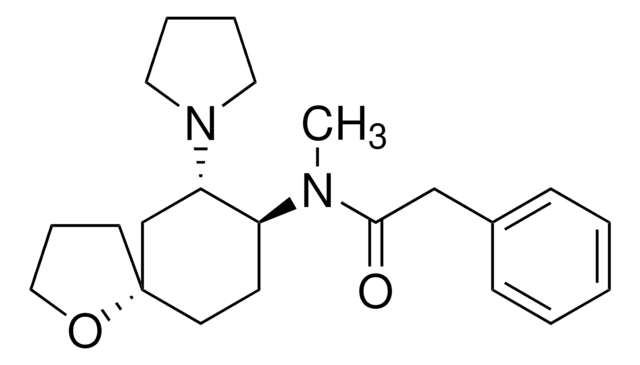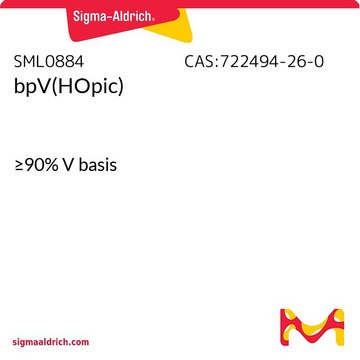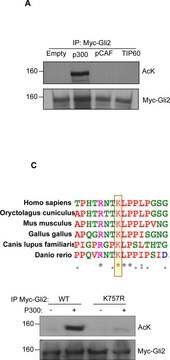06-867
Anti-phospho-STAT5A/B (Ser726/Ser731) Antibody
serum, Upstate®
Sign Into View Organizational & Contract Pricing
All Photos(1)
About This Item
UNSPSC Code:
12352203
eCl@ss:
32160702
NACRES:
NA.41
Recommended Products
biological source
rabbit
Quality Level
antibody form
serum
antibody product type
primary antibodies
clone
polyclonal
species reactivity
rat, human, mouse
manufacturer/tradename
Upstate®
technique(s)
western blot: suitable
isotype
IgG
NCBI accession no.
UniProt accession no.
shipped in
dry ice
target post-translational modification
phosphorylation (pSer726)
Gene Information
human ... STAT5A(6776)
Specificity
phosphorylated STAT5A (S726) and STAT5B (S731), does not recognize STAT5B containing a S731A mutation
Immunogen
peptide (DQAP[pS]PAVC) corresponding to amino acids 722-730 of human STAT5A or 727-735 of human STAT5B
Application
Anti-phospho-STAT5A/B (Ser726/Ser731) Antibody is a rabbit polyclonal antibody for detection of phospho-STAT5A/B (Ser726/Ser731) also known as signal transducer & activator of transcription 5A/B & has been tested in WB.
Research Category
Epigenetics & Nuclear Function
Epigenetics & Nuclear Function
Research Sub Category
Transcription Factors
Transcription Factors
Quality
routinely evaluated by immunoprecipitating STAT5A from RIPA lysates of Nb2-Sp cells that had been treated with prolactin; subsequent immunoblotting was performed using Anti-STAT5A (Catalog #06-968)
Target description
94kDa
Physical form
Antiserum
rabbit antiserum in 30% glycerol and 0.05% sodium azide
Storage and Stability
2 years at -20°C
Legal Information
UPSTATE is a registered trademark of Merck KGaA, Darmstadt, Germany
Disclaimer
Unless otherwise stated in our catalog or other company documentation accompanying the product(s), our products are intended for research use only and are not to be used for any other purpose, which includes but is not limited to, unauthorized commercial uses, in vitro diagnostic uses, ex vivo or in vivo therapeutic uses or any type of consumption or application to humans or animals.
Not finding the right product?
Try our Product Selector Tool.
Storage Class Code
12 - Non Combustible Liquids
WGK
WGK 1
Flash Point(F)
Not applicable
Flash Point(C)
Not applicable
Certificates of Analysis (COA)
Search for Certificates of Analysis (COA) by entering the products Lot/Batch Number. Lot and Batch Numbers can be found on a product’s label following the words ‘Lot’ or ‘Batch’.
Already Own This Product?
Find documentation for the products that you have recently purchased in the Document Library.
Development of pure prolactin receptor antagonists.
Bernichtein, S; Kayser, C; Dillner, K; Moulin, S; Kopchick, JJ; Martial, JA; Norstedt et al.
The Journal of Biological Chemistry null
Two discrete regions of interleukin-2 (IL2) receptor beta independently mediate IL2 activation of a PD98059/rapamycin/wortmannin-insensitive Stat5a/b serine kinase.
Kirken, R A, et al.
The Journal of Biological Chemistry, 272, 15459-15465 (1997)
P L Bergad et al.
The Journal of biological chemistry, 275(11), 8114-8120 (2000-03-14)
A growth hormone-inducible nuclear factor complex (GHINF), affinity-purified using the growth hormone response element (GHRE) from the promoter of rat serine protease inhibitor 2.1, was found to contain Stat5a and -5b, as well as additional components. The ubiquitous transcription factor
H Yamashita et al.
The Journal of biological chemistry, 273(46), 30218-30224 (1998-11-07)
Transcription factors of the Stat family are controlled by protein kinases. Phosphorylation of a positionally conserved tyrosine residue is obligatory for Stat dimerization, nuclear translocation, and specific DNA binding. Studies of Stat1 and Stat3 have suggested that serine phosphorylation may
R A Kirken et al.
The Journal of biological chemistry, 272(22), 14098-14103 (1997-05-30)
Transcription factors of the Stat gene family are selectively activated by many hormones and cytokines. Stat5 originally was cloned as a prolactin-stimulated DNA-binding protein, but is also activated by non-lactogenic cytokines in many cell types. The recent identification of two
Our team of scientists has experience in all areas of research including Life Science, Material Science, Chemical Synthesis, Chromatography, Analytical and many others.
Contact Technical Service







